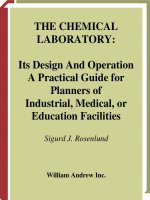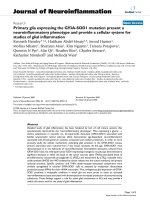the chemical laboratory its design and operation a practical guide for planners of industrial, medical, or educational facilities
Bạn đang xem bản rút gọn của tài liệu. Xem và tải ngay bản đầy đủ của tài liệu tại đây (6.99 MB, 173 trang )
THE CHEMICAL
LABORATORY:
Its Design And Operation
A Practical Guide for
Planners of
Industrial, Medical, or
Education Facilities
Sigurd J. Rosenlund
William Andrew Inc.
THE CHEMICAL LABORATORY:
ITS DESIGN
AND
OPERATIONTHE
CHEMICAL
LABORATORY:
ITS
DESIGN AND
OPERATION
A Practical Guide for Planners
of
Industrial, Medical,
or
Educational Facilities
by
Sigurd J. Rosenlund
~p
NOYES PUBLICATIONS
L :.:.!::J
Park Ridge,
N_
JersBY,
U.s.A.
Copyright
©
1987
by
Sigurd
J.
Rosenlund
No
part
of
this
book
may
be reproduced
in
any
form
without
permission
in
writing
from
the
Publisher.
Library
of
Congress Catalog Card
Number:
86-31183
ISBN:
0-8155-1110-8
Printed
in
the
United
States
Published
in
the
United
States
of
America
by
Noyes
Publications
Mill
Road, Park Ridge,
New
Jersey
07656
10
9 8 7 6 5 4 3 2 1
Library
of
Congress Cataloging-in-Publication Data
Rosenlund, Sigurd J.
The
chem ical
laboratory.
Includes
index.
1. Chemical laboratories Design and
construction.
2.
Chemical laboratories Management. I.
Title.
[DNLM]
:
1.
Chemical
industry.
2.
Facility
Design and
Construction.
3.
Laboratories organization
&
administration.
QD
51
R814c]
QD51.R57
1987
542'.1
86-31183
ISBN
0-8155-1110-8
Preface
It
is
my
hope
that
this
book
will fill a gap
on
the
technical
library shelf
by
offering help
to
those
involved
with
either
planning
new
laboratories
or
expanding existing
ones.
It
is based
on
over
thirty
years
of
laboratory
experience, including
day
to
day
operation,
design
of
new
facilities, supervision
of
construc-
tion,
and
consultation.
I have witnessed
the
fruits
of
good
planning
and
the
unfortunate
consequences
where
planning
was
inadequate.
Who
can
profit
from
such
a
book?
The
supervising
chemist
who
must
define
the
needs
of
a new
laboratory
will find
many
practical suggestions. So will
the
administrator
looking for
ways
to
justify
a facility
that
will
not
become
outdated
in a
few years.
The
designer
or
engineer will
be
better
able
to
see
things
from
a client's viewpoint, as will
the
contractor
in charge
of
certain
aspects
of
construction.
The
doctor
or
dentist
setting
up
a
laboratory
facility
next
to
the
office will discover
suggestions
for
making
the
best
use
of
limited space.
The
supplier
of
laboratory
furniture
and
equipment
will find new
ways
to
advise his customers. Finally,
the
young
chemist
who
finds himself charged
with
starting
up
a new
operation
will
have
the
reference I wished
for
when
I was in
that
position
many
years ago.
Above all,
this
book
is
intended
to
be
a practical guide
to
laboratory
planning.
It
will
not
go
into
the
more
sophisticated
v
vi Preface
areas
of
science
and
technology,
Instead,
it
will
deal
with
a
broad
variety
of
more
common
matters,
some
of
which
may
be
overlooked
or
underestimated
by
the
laboratory
planner.
Perhaps
an
explanation
should
be
offered
here
for
my
use
of
"he"
throughout
the
book
in referring
to
the
person
in charge
of
daily
laboratory
operation.
This
pronoun
is
used
in
its tradi-
tional
sense
to
refer
to
either
a
man
or
a
woman.
The
newer
"he
or
she,"
while
more
accurate,
considering
the
many
women
in
charge
of
laboratories
today,
is
also
more
cumbersome
and
has
been
avoided
for
that
reason.
I
would
like
to
thank
all
those
who
have given
their
time
and
thoughtful
comments.
Benjamin F.
Naylor,
chemistry
professor
emeritus
of
San
Jose
State
University,
read
the
manuscript
in
its early stages
and
contributed
valuable
information
on
educa-
tionallaboratories.
Alan C.
Nixon,
past
president
of
the
Ameri-
can
Chemical
Society,
along
with
other
members
of
Calsec
Consultants,
Inc.,
offered
helpful
suggestions
from
their
diver-
sified experiences.
Numerous
laboratory
personnel
guided
me
through
their
facilities,
and
distributors
of
laboratory
products
kept
me
informed
about
their
latest
products.
Plumbers, elec-
tricians,
and
others
in
the
building
trades
had
many
practical
hints.
Finally, I
would
like
to
thank
my
wife, Barbara,
for
her en-
couragement,
suggestions,
and
countless
hours
of
editing.
January
1987
NOTICE
Sigurd
J.
Rosenlund
To
the
best
of
the
Publisher's
knowledge
the
informa-
tion
contained
in
this
book
is
accurate;
however,
the
Publisher
assumes
no
responsibility
nor
liability
for
er-
rors
or
any
consequences
arising
from
the
use
of
the
in-
formation
contained
herein.
Final
determination
of
the
suitability
of
any
information,
procedure,
or
product
for
use
contemplated
by
any
user,
and
the
manner
of
that
use,
is
the
sole
responsibility
of
the
user.
The
book
is
intended
for
informational
purposes
only.
Expert
advice
should
be
obtained
at
all
times
when
implementation
is
being
considered.
Due
caution
should
be
exercised
in
the
han-
dling
of
equipment
and
construction
of
facilities.
Contents
INTRODUCTION
1
1.
PRELIMINARY
PLANNING
4
Listing
Operations
5
Estimating
Space
Requirements
6
Work
Bench
Space 8
Free-Standing
Equipment
9
Arguments
for
Additional
Space 9
Educational
Laboratory
Requirements
9
Fume
Hoods
10
Analytical Balances
10
Other
Equipment
10
Planning
for
the
Future
11
Storage
Areas
11
Industrial,
Medical,
and
Research
Laboratories
11
Educational
Laboratories
12
Reagent
Storage
12
Glassware
12
Instruments
12
Preparation
Space
13
Repair
and
Maintenance
13
Equipment
Check-Out
13
Laboratory
Location
13
Safety
Considerations
14
Efficiency
Needs
14
Environmental
Considerations
15
vii
viii
Contents
Vibration
15
Sunlight
15
Noise
16
Access
to
Utilities
16
Zoning Regulations
16
2.
LABORATORY
LAYOUT
17
Limitations
18
Making
the
Scale Drawing
18
Room
Organization
19
Work
Patterns
20
Work
Bench
Dimensions
20
Bench
Configuration
21
Storage
Cabinets
and
Shelves
22
Heat-Producing
Equipment
22
Toxic
and
Flammable
Materials
23
Analytical Balances
23
Sample
Receiving
23
Office Space
23
Workers' Area
24
Supervisor's Area
24
Furniture
Dimensions
24
Safety
Shower
24
Completing
the
Layout
25
3.
UTILITY
REQUIREMENTS
27
Hot
and
Cold Water 27
Deionized Water
28
Distilled Water 29
Gas
30
Electric
Power
30
Sewer
Connection
31
Compressed Air
and
Vacuum
32
Ventilation
32
Heating
and
Cooling
35
4.
LABORATORY
SAFETY
36
Safety
Awareness
36
Sources
of
Safety
Information
38
Dealing
with
Authorities
39
Ventilation
Systems
42
Flammable
Materials
43
Contents
ix
Chemical Spills
44
Safety
Shower
and
Eyewash
Station
45
Chemical
Storage
45
Fire
Protection
47
Earthquake
Preparedness
48
Mechanical Hazards
48
Equipment
49
Doors
49
Utility
Failures
50
Electricity
50
Water Pressure
50
Gas
50
How
to
Handle Utility Failures 51
Personal
Protection
51
Safety
Glasses 51
Lab Coats
52
Foot
Protection
52
Food
and
Drink
53
Smoking
53
Hair
Protection
53
Safety
Signs
54
Conclusion
54
5.
POLLUTION
CONTROL
AND WASTE DISPOSAL
55
Waste
Control
Regulations
55
Air
Pollution
56
Liquid
Waste
57
Solid Waste
58
Waste Collection
and
Disposal
58
Disposal Containers
58
Waste Storage
59
Waste Disposal Services
59
In-House Waste
Reduction
60
Disposal
of
Old
Chemicals
61
Different
Laboratories,
Different
Problems
62
The
illusion
of
Dilution
62
6.
FLOORS,
WALLS, AND CEILINGS
64
Flooring
Materials
64
Vinyl
65
Concrete
66
Rubber
Composition
66
x
Contents
Other
Materials
66
Wall
Treatment
67
Paint
Quality
67
High Resistance Paints
68
Ceiling
Treatment
69
Lighting
70
Interior
Decoration
for
the
Laboratory
71
Color Choices 71
7. WORK BENCHES AND FUME HOODS
73
Suppliers
73
Cabinet
Construction
. . . . . . . . . . . . . . . . . . . . . . . . . . .74
Wood versus Steel . . . . . . . . . . . . . . . . . . . . . . . . . . . .74
Assessing
Quality
75
Kitchen
Cabinets
76
Work
Bench
Components
77
Work
Top
Materials
78
Stone
Tops
78
Cement
Composition
78
Solid
Epoxy
79
Plastic
Laminate
79
Compressed Wood
Fiber
79
Ceramic Sheets . . . . . . . . . . . . . . . . . . . . . . . . . . . . . .80
Ceramic Tile . . . . . . . . . . . . . . . . . . . . . . . . . . . . . . . .80
Stainless Steel . . . . . . . . . . . . . . . . . . . . . . . . . . . . . . .80
Choice
Factors
. . . . . . . . . . . . . . . . . . . . . . . . . . . . . . . .80
Work
Top
Protection
82
Fume
Hoods
82
Hood
Construction
83
Installation
83
Building a Simple
Hood
84
Ductless
Hoods
. . . . . . . . . . . . . . . . . . . . . . . . . . . . . .84
Modular
Furniture
85
8.
UTILITY
OUTLETS
86
Mounting
Outlets
86
Hot
and
Cold Water
87
Deionized Water
88
Sinks
and
Drains
89
Gas 91
Compressed
Air
91
Electrical
Outlets
92
Contents
xi
Compressed
Gases
93
Conclusion
94
9.
FINAL
PLANS AND
CONSTRUCTION
95
Checking
Final
Plans
96
Construction
97
Misunderstandings
97
Expecting
the
Unexpected
98
Safeguarding
Equipment
Information
99
10.
EQUIPMENT AND SUPPLIES
100
Equipment
Sources
100
Laboratory
Supply
Houses
100
Factory
Direct
100
Order
Companies
101
Science
Shops
101
Hardware
and
Electronic
Stores
101
Drugstores
and
Sup~rmarkets
101
Where
to
Obtain
Information
on
Suppliers
101
Selecting
Equipment
102
Selecting Supplies
103
Cost
Estimates
103
Ordering
104
Receiving
Equipment
and
Supplies
105
Capital
Equipment
106
Equipment
Identification
107
11.
THE
LABORATORY
IN
OPERATION
108
Staffing
the
Laboratory
108
Application
Forms
109
Resume
or
Letter
110
The
Interview
110
Final
Selection
111
Notifying
Applicants
111
Job
Responsibilities
111
On
the
Job
Training
112
Reports.
. . . . . . . . . . . . . . . . . . . . . . . . . . . . . . . . . . .112
Ordering
Supplies
112
Supply
Sources
113
Dead
Files
and
Old
Samples
114
Laboratory
Housekeeping
. . . . . . . . . . . . . . . . . . . . . .114
Setting
the
Rules.
. . . . . . . . . . . . . . . . . . . . . . . . . .115
xii
Contents
Janitorial Services
115
Cleaning Materials
116
Keeping
Track
of
Cost
116
Laboratory
Ethics
118
12.
LABORATORY RECORDS
120
Laboratory
Notebooks
120
Methods
of
Record
Keeping
121
Research
and
Development
121
Analytical Laboratories
122
Sample Recording
123
Records
of
Tests
123
Industrial Laboratories
123
Quality
Control
Records
124
Product
Sample Records
124
Poor
Record
Keeping
124
Purchasing Records
125
Personnel Records
125
Maintenance Records
125
Records
of
Procedures
126
Paperwork
Reduction
126
Computerized
Records
128
Conclusion
129
13.
THE
LABORATORY
HANDYMAN
130
Limitations
130
Value
of
Laboratory
Handyman
131
Related Experience
131
Sources
of
Information
132
Tools
for
the
Laboratory
132
Sources
of
Tools
132
Tool
Storage
133
Special Purpose Tools
133
Tool
Rental
133
Routine
Maintenance
134
Faucets
134
Sink Traps \
.134
Wires
134
Electric Plugs
135
Light Bulbs
135
Equipment
Maintenance
135
Major Projects
135
Contents
xiii
Examples
of
Laboratory
Handiwork
136
Equipment
Rack
136
pH Meter
Stand
136
Incubator
136
Some
Negative Examples
137
Careless Workmanship
137
Dangling Cords
137
Poor
Quality Materials
137
Salvaging Fire-Damaged
Equipment
138
Repair Methods
138
Drying Oven
138
A Learning Experience
139
14.
A CASE
HISTORY
140
Selecting
the
Location
140
Preliminary Planning
141
Detailed
Room
Layout
142
Utility
Requirements
144
Ventilation
145
Lighting
146
Laboratory
Benches
and
Work
Tops
146
Sinks, Faucets,
and
DI
Water
147
Flooring, Paint,
and
Ceiling
Treatment
149
Furniture
Installation
150
Equipment
and
Supplies
150
Safety
Considerations
152
Conclusion
153
INDEX
154
A laboratory may come in any size or shape.
It
may be a room
in
an industrial plant, a wing of a hospital, or a whole building
on
a
college campus. All of these present similar problems and
deci-
sions
at
the planning stage. Where should the laboratory be
located? How much space is required? Will a proposed layout
contribute to smooth traffic
flow?
What utilities are needed?
What safety factors should be built
in?
These are
just
some of
the major questions planners must address.
The results ofpoor planningusually
do
not show up until a
facili-
ty
hasbeenin operationfor some time. By then, correctingthem
is invariably expensive. Anyone who has worked in a laboratory
for even a short period has seen some of these problems. There
may be overcrowded workbenches, where permanent equip-
ment and set-ups leave little or
no
room for non-routine work,
or
inadequate wiring which requires the use of cumbersome and
hazardous extension cords
on
a permanent basis. Poor ventila-
tion is a common problem, causing both discomfort and hazards.
Improperly chosen bench tops may be stained by chemicals or
damaged by heat. Many laboratories have awkward traffic pat-
terns, resulting in wasted time during performance of routine
tasks. Storage areas may be inadequate or poorly located. The
list goes on and on.
1
2
The
Chemical
Laboratory:
Its
Design
and
Operation
Many will blame such problems
on
lack of funds when the
laboratory was built. This may not be the case. A well-planned
and efficient laboratory does not have to cost more than a poorly
planned one.
It
is mostly a
matter
ofputting the available money
to work where it counts most. This book gives many examples
where money can be saved without causing operational pro-
blems later.
It
also presents cases where additional money spent
at
the outset has paid off in a safer and more efficient operation
for years to come.
Who plans and builds a laboratory? In a small facility the whole
job is often handled by in-house talent. I have seen many cases
where such talent was capable oftaking on
the
challenge. I have
also seen numerous cases where professional assistance should
have been employed. This book will help
the
do-it-yourselfer
decide when such assistance is needed.
At
the other end of
the
spectrum, a design
or
engineering
fl.rn1
may be hired to
do
the
job
on
a turn-key basis. Such a
fl.rn1
can guarantee professional
results,
but
will these be specifically tailored to
the
needs ofthis
particular laboratory? Examples of both underdesign and
overdesign, usually resulting from poor communication bet-
ween designer and client, are given.
Throughout the book, the person in charge of day-to-day opera-
tions is referred to as the
laboratory operator. This is not an
ad-
ministrator or supervisor located in an office down the hall or in
another building. The laboratory operator must be heavily
in-
volved in all aspects of planning. Only he can estimate space re-
quirements, check a proposed layout for practical and safe
operation, and recommend allowances for future expansion.
Regardless of the amount of professional assistance available,
the laboratory operator can expect to burn much midnight
oil.
During construction he must be available
at
all
times to take
care of those numerous problems nobody had predicted.
This book not only deals with major matters, such as laboratory
size and location, layout, and utilities.
It
also includes seemingly
minor topics, such as choice ofpaints andfloor coverings, money
saving hints for utility hookups, and types ofceiling treatment.
Introduction
3
Safety and waste disposal are
treated
in detail because of their
ever
increasing importance.
Planning and building a laboratory requires a cooperative effort
involving administrators, designers, equipment supply houses,
contractors, and the laboratory operator. A laboratory designed
for efficient operation can be achieved only
if
all of them work
together with mutual respect and the
best
possible communica-
tion.
1
Preliminary
Planning
Once it has been decided
that
a new laboratory should be built,
some important basic planning must be done. Whether ornot an
architect or designer is to be called in later, those in charge of
the laboratory operation will need to consider questions such as
these:
What types
or
work will be performed both
i.n-
itially and in
the
foreseeable future?
Will any of this work create special hazards?
What equipment will be required?
Will any of
the
work produce excessive fumes,
heat, dust,
or
noise?
Should any of
the
jobs be performed in isolated
areas
or
in separate rooms?
Will any tasksrequire a controlled environment?
How much room will be taken up by perma-
nently installed equipment?
How much space will be needed for undesig-
nated work areas?
Where should the laboratory be located relative
to other facilities?
4
Preliminary Planning 5
Are there any special security requirements?
Facing such questions head-on from the earliestplanningstages
and making notes as information is gathered
will
help to avoid
unpleasant surprises later
on.
LISTING OPERATIONS
It
is important to make a list ofeverytask
that
will
be performed
in the laboratory, down to the smallest detail. Operations such
as
pH
measurements, transfer of flammables from safety stor-
age to shelfbottles, orrecording observations must not be over-
looked. Even
in
a small laboratory, the number of individual
tasks
will
be quite substantial.
Each operation
on
the list should then be evaluatedfor problems
it might create and for any special requirements. These might
include the following:
Hazards the operation may create and what
precautions must be taken (fume hood, separate
room, etc.)
Non-hazardous nuisance it may cause (odor,
dust, heat, noise, steam, etc.)
Possible contamination of other work being per-
formed.
Vibration or other disturbance of other opera-
tions.
Special environment needed (controlled temper-
ature, clean-room conditions, absence of drafts,
etc.)
Security requirements (controlled access to cer-
tain instruments or operations, etc.)
It
will
take time to come up with
all
of this information, par-
ticularly
in
cases where new types ofwork are contemplated.
If
6
The
Chemical
Laboratory:
Its Design
and
Operation
a new piece of equipment is to be installed, planners should
ob-
tain as much literature as possible from the manufacturer and
make a careful check ofprocedures for which it
,viII
be used.
If
it
can be arranged, a visit to another laboratory in
\\Thich
this
in-
strument is already
in
use will prove very helpful.
It
is not only the new work
that
will
need evaluation, however.
Even operations
that
have been performed for many years
should be reviewed and updated as needed. Safety require-
ments, for example, could have been changed, as will be
dis-
cussed
in
Chapter
4.
A partial check list of operations for an industrial chemical
laboratory is shown in Table
1.
The format of a formal list
will
vary considerably from one laboratory to another, butwith such
an aid, one can easily see which operations are compatible and
then group these together. Those
that
need special treatment
will readily stand out. The planner will also be able to estimate
the number ofrooms required for the total operation. Finally, a
complete list of all laboratory functions
will
facilitate the next
step, an estimate of space requirements.
ESTIMATING SPACE
REQUIREMENTS
A typical laboratory
that
has been in operation for some time
usually has run out of space for optimum operation. In some
cases, the space may be there but cannot be utilized to
full
ad-
vantage. Work benches gradually
get
covered with permanent
equipment set-ups, leaving little room for other work. Lack of
storage space for supplies and samples becomes the rule
rather
than the exception. Adequate room for a desk, bookcase, or
typewriter has often been overlooked. As more personnel is
ad-
ded, these problems become critical. Overcrowding also has a
serious effect
on
safety.
Since such conditions are evident
so
soon in many cases, it is
ob-
vious
that
they could have been avoided by more careful plan-
ning. The most important space requirements to consider are
Table 1: Checklist
of
Operations
Operation
Hazards,
Problems
Conditions
Required
(7)
Ct-t
Q)
0
E
0
:3
Q)
C
Soo4
Ct-t
Soo4
>
0 c
p ~
0
C
~
"~
0
C
Q)
'0
C 0
'0
'Ot/)
~
" 4
t/)
CQ)
>
~
0 0
"~
0
00
~
~
t/)
"~
~
" 4
~
.~
~
o
~
0
Soo4
Soo4
~~
~~
~
t/)
"~
.
~
ro
.c
ro
.c
Soo4
,lJ
ro~
t/)o
t/)
0 0
Q)
ro
Q)
Soo4
"~
Ot/)
"~
" 4.~
Q)" 4
0S004
:3
Q)
Soo4
" 4
~
~
Soo4
to
.; :l
ro
Q)
OQ)
OQ)
>
O~
tOt/)
~" 4
'0
Soo4
Soo4
><
0
ro
,lJ
.r-i
to
P4
~
Q)E
E
Q)C
0
p >
" 4
0
0
E
Q)
•
4
0
:3
(l)
p :3
o
:3
0
p (l)
Ho
><s::
0
tL.
U
8
tJ)
X
>
Z
0
tJ)
tL.
tJ)t, j
Zt, j
Z
tJ»
U.; :l
~(l)
z
Analytical
weighings
X
X X
X
Ether
extractions
X
X
X
X
Powder
screening
X
X
X X
Muffle
furnace
X X
X
Drying
oven
X X
X
Solvent
evaporation
X X
X
X
X
Solvent
dispensing
X
X
X
X
Solution
preparation
X
X
X
X X
Perchloric
acid
digestions
X X
X
Kjeldahl
digestions
X
X X
X
X
X X
Desk
work,
telephone
X
X
X
Vacuum
pump
X X
X
Microscopic
work
X
X
X
X
etc.
~
ro
s"
S'
~
~
""'d
~
~
~
5"
(JQ
l
8
The
Chemical
Laboratory:
Its
Design
and
Operation
those for work benches, free-standing equipment, office space,
and storage.
In
addition, due attention must be paid to
the
fact
that
some work areas must be separatedto avoid hazards
or
con-
tamination.
Work
Bench
Space
The
fIrst step in space planning should be to estimate how much
bench space
",rill be required. Benches must accommodate vari-
ous pieces of permanently installed equipment and still have
room for both frequently performed and special one-time tasks.
Benches may be either installed against the wall or placed back
to back in peninsulas or islands. The exact configuration will be
worked out later.
For
now, what is important is the total num-
ber
of running feet of bellch space
that
will
be required.
All
bench-mounted equipment should be listed with its dimen-
sions, wllich can be taken from measurements
or
from catalog
data.
It
should be noted which instruments may have to be
put
at
a certain minimum distance from other objects in order to
avoid interference or allow for servicing.
Worl{
space should be
allowed next to each instrument for samples, notebooks, etc.
This space may be considerable in case of an analytical instru-
ment
on
which many samples
are
to be tested
at
one time. Space
sharing should be discouraged, with the required work space
next to an instrument reserved for
that
alone. Sinks and fume
hoods should also be included
in
this list, with an allowance of
at
least
18
inches of free space
on
each side of a sink.
When all equipment has beenlisted, thetotal number ofrunning
feet needed can be added up. How much more will be required?
This will vary from one laboratory to another.
In
an industrial
laboratory where both routine testingand product development
work
are
to beperformed, this figure can safely bemultiplied by
four for a realistic estimate.
In
some laboratories used exclusive-
ly for specific types of work with
no
other types contemplated,
this figure may be lower.
It
should be kept in mind, however,
that
expandingan existinglaboratoryis an extremely expensive
Preliminary Planning 9
undertaking.
It
is desirable, therefore, to have some unused wall
space and some free floor area when a new laboratory begins
operation.
Free-standing
Equipment
There is more to a laboratory than work benches and the instru-
ments mounted
on
them. Free-standingequipment mustalso be
considered. This includes refrigerators, safety storage cabinets
for chemicals, safety shower, desk space, typewriter stand or
computer terminal, or any other equipment
that
is not bench-
mounted. File cabinets, which are real space-robbers, must not
be forgotten. In one laboratory, much space was saved by plac-
ing two-drawer
file
cabinets beneath the large table used for
sorting samples.
Arguments for Additional Space
Careful scrutiny of
all
these measurements
will
soon show a
lab-
oratory planner
that
much more space is required than was
originally thought. Next comes the competition for this space,
at
which time convincing evidence must be produced. One labora-
torymanager proudly showed offhis new facility, the product of
such a battle. Yes, he had been accused of taking up far more
space than he really needed. He had done his homework,
how-
ever, and presented management with enough data to convince
them. Although his laboratory had much free floor space and a
whole empty wall, he had looked into future plans and knew
what would be required before too long. He also had spare
cir-
cuits in the breakerbox and plumbing which could readily be
ex-
panded.
EDUCATIONAL LABORATORY REQUIREMENTS
Figuring space for educational laboratories requires some
dif-
10
The
Chemical
Laboratory:
Its Design
and
Operation
ferent considerations.
For
a given course, a certain amount of
bench space must be allotted to each student. Only those in
charge ofthe course are able to make a realistic estimate ofthis.
In addition, since each work station is used by more than one
student, there should be sufficient space beneath it or close by
for individual lockers or drawers. Organic laboratories usually
require more space
per
student because of the equipment set-
ups used and the need for separation to avoid fire hazard. The
total amount of bench space thus depends
on
the number ofstu-
dents each room is designed for.
Fume Hoods
In an educational laboratory, fume hood space requirements are
substantial, since
so
many students need a hood
at
the
same
time. Many operations
that
used to be performed on
the
bench
must now be done in a hood for safety reasons. Inadequate hood
space has caused many problems even in fairly modern universi-
ty
chemistry buildings.
Analytical Balances
Most educational laboratories keep their analytical balances in
separate rooms, which are locked when not in use. Balances less
than threefeet
apart
are crowded,
so
sufficient space mustbe
al-
lowed. Such rooms will also be useful for other instruments,
such as
spectI:ophotometers,
that
do
not give off heat or fumes.
Other Equipment
Large capacity balances, centrifuges, and similar equipment are
generally placed
on
a separate counter away from the benches.
The size ofthis counter mustbe carefully estimated. There must
also be room for equipment and supplies kept in the laboratory
as opposed to the stockroom. Of course, space must also be
al-
lowed for a safety shower and eyewash station.









